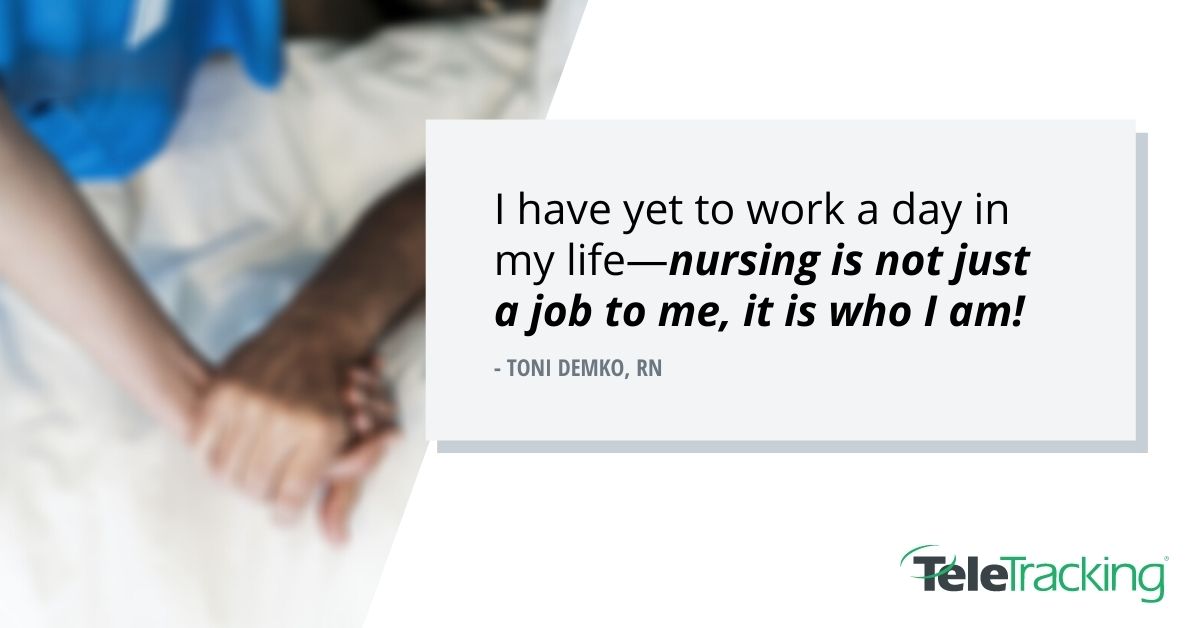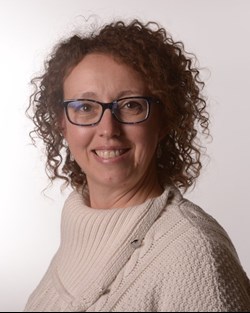Toni Demko, RN, The Next Profile in a Year Long Celebration of the Amazing Accomplishments of Nurses
We started this blog series in January as a way to recognize the nurses that we have the honor of working with every day―and to be a part of the World Health Organization’s designation of 2020 as the “Year of the Nurse and Midwife.” We always knew that nurses around the globe deliver kind, compassionate care to patients in their times of greatest need—they hold the hand of an elderly patient; dry the tears of a frightened child; and comfort grieving family members. With the COVID-19 pandemic, nurses and all healthcare professionals are on the frontlines―continuing to serve, continuing to deliver care and continuing to be there for their communities during the greatest public health crisis in a century. Our sincerest thanks to the nurses who are working hard—under very difficult conditions—to ensure that no patient will wait for the care they need.

1. Why did you decide to become a nurse?
After serving eight years in the Army, I was feeling a little uncertain about what to do next. For the eight years that I was in the military, my life had been very structured—I knew what was expected of me and I did it. When I completed my military service, I wanted to do something that would be both meaningful and enjoyable to me.
That desire to find something that would inspire me, led to me shadowing the mother of a friend who was a nurse. As I spent the day with her, I knew this was what I wanted to do. Taking care of people just simply felt right. Once I started down that path, I have yet to work a day in my life—nursing is not just a job to me, it is who I am!
2. What are the biggest differences you’ve seen in the profession since you started your career?
The introduction of the EMR and other advancements in technology. Those things have impacted and changed how we chart, the way we document procedures and diagnostics, how we deliver care, and the factors that care is based on. The key is finding the right balance between the benefits technology brings, while not losing the personal, human side of nursing.
3. What is the biggest challenge(s) facing nurses today?
I believe nurses face two big challenges. The first is the nursing shortage across the United States. Nurses are such important figures in ALL realms of healthcare, as well as non-healthcare entities, such as technology companies, medical suppliers, pharmacology companies, device companies, and government roles. The second challenge relates to nurses leaving the bedside for higher-paying jobs in other areas of healthcare. We are an aging society with more disease processes and comorbidities—and that means we need even more nurses to deliver compassionate care.
4. What do you think can be done to solve the nursing shortage?
I wish I had a magic wand to solve the shortage. I believe there are multiple parts to this solution. We must be creative and keep the current workforce at the bedside longer. This could be done with incentives, long-term training opportunities, and use of more seasoned nurses as recruiters. We also need to work with people of all ages to show the vast opportunities within our profession. It is no longer just patient care.
5. Share a patient story that has impacted you personally.
This is an interesting question. There is not just one patient or family member that has impacted me. Every patient that I have touched has touched me. Each patient and family have molded my view of nursing and/or my view of the world—the first time I watched a birth in nursing school as a graduate nurse; the first time I watched a patient take his last breath, knowing there was nothing that I could do; the time I cared for a 36 year old woman going through a routine procedure, only to lose her arms and legs due to complications; and the daughter that hugged me for treating her mother as though she was my own.
Depending on my situation, I think of different moments with patients. One that stands out is the husband who needed emergency surgery to save his life, only to find out his wife was losing hers—and making the decision to pull his bed in with hers, so he could hold her one last time. Being a nurse has impacted me and has made me who I am.
6. The World Health Organization has designated 2020 the International Year of the Nurse and the Midwife. Why is this type of recognition so important?
Being recognized by a group that manages global health issues, is an amazing honor. Nurses make up 50% of healthcare personnel. We, as nurses, have such an impact on diseases, education, health promotion and care delivery. This type of recognition could help advance nurses in the professional arena. This could also bring more visibility to the nursing field and attract potential students to the nursing profession.
7. How does TeleTracking help nurses and other health professionals deliver a better patient experience?
One of the most recent examples occurred while I was working with a client providing COVID-19 support. The client stated that if it was not for TeleTracking—and the support we have given them during this time—she did not know what they would’ve done. TeleTracking provided them with visibility, the ability to track patients from pending to confirmed discharge, the ability to know their staffing, room types and open beds from one central location. This information also made it possible to provide essential information to the state quickly and efficiently, and then get back to caring for patients. Finally, team members are able to effectively track the path of patients, reducing potential exposures for transporters and increasing awareness of cleaning demands for EVS.
8. How are TeleTracking’s health system command centers helping improve access across the care continuum?
In a single word, transparency.
It is absolutely amazing to have visibility into every bed in a multi-facility health system. Not only is one person able to see every bed, in every facility—they also have the ability to see the bed type, the patient type, and how long they have been waiting. When I started my nursing career, this was managed from a single piece of paper. At my first hospital, we did not know what was happening on our own unit, not to mention the hospital or other hospitals within the system. Now today, with a global pandemic occurring, we are able to provide clients with information to continue planning and assist with this unique challenge. Hospitals can monitor the entire situation from a single point and ensure that no patient waits for the care they need.
When patients can receive care faster, they recover faster!
More about this blog post
About the Expert
 Toni Demko, RN
Toni Demko, RN
clinical application consultant
Toni Demko, RN is a Clinical Application Consultant with TeleTracking. Prior to that role, she worked as a Clinical Operations Advisor and a Product Manager with the organization. Toni’s experience also includes working at the bedside as a Professional Staff Nurse at UPMC Shadyside in Pittsburgh. She has earned her Lean Six Sigma Green Belt and had a chapter published on smart technology in the Handbook of Informatics for Nurses and Healthcare Professionals, Fifth Edition.
We're glad you're enjoying our resources! Please tell us more about you to access our full library.
This will allow us to personalize your experience on TeleTracking.com. Of course, we will never sell your information and you can opt-out at any time. Need help now? Contact a Patient Flow expert.
Leaving the website
You're about to leave this website, to one of our affiliates or another information source.